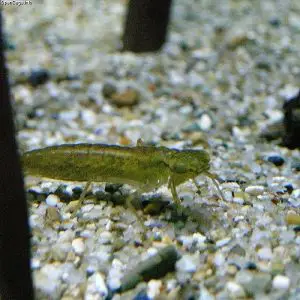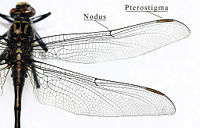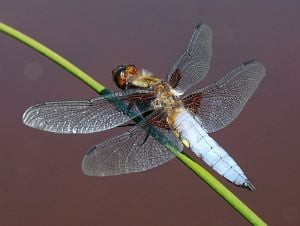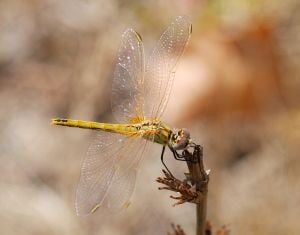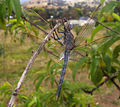Difference between revisions of "Dragonfly" - New World Encyclopedia
(article imported, foreign language links removed, credits applied) |
(→Dragonflies in culture: retrieve date added) |
||
| Line 1: | Line 1: | ||
| − | |||
| − | |||
{{Taxobox | {{Taxobox | ||
| color = pink | | color = pink | ||
| Line 30: | Line 28: | ||
A '''dragonfly''' is an [[insect]] belonging to the order [[Odonata]], the suborder [[Epiprocta]] or, in the strict sense, the infraorder '''Anisoptera'''. It is characterized by large [[compound eye|multifaceted eyes]], two pairs of strong transparent [[insect wing|wings]], and an elongated body. | A '''dragonfly''' is an [[insect]] belonging to the order [[Odonata]], the suborder [[Epiprocta]] or, in the strict sense, the infraorder '''Anisoptera'''. It is characterized by large [[compound eye|multifaceted eyes]], two pairs of strong transparent [[insect wing|wings]], and an elongated body. | ||
| − | Dragonflies typically eat [[mosquito]]es, [[midges]] and other small insects like [[fly|flies]], [[bee]]s, and [[butterfly|butterflies]]. They are usually found around | + | Dragonflies typically eat [[mosquito]]es, [[midges]] and other small insects like [[fly|flies]], [[bee]]s, and [[butterfly|butterflies]]. They are usually found around [[lake]]s, [[pond]]s, [[stream]]s, and [[wetland]]s because their [[larva]]e, known as "[[nymph (biology)|nymphs]]," are aquatic. Dragonflies do not normally bite or sting humans (though they will bite in order to , if grasped by the abdomen); in fact, they are valued as a [[predation|predator]] that helps control the populations of harmful insects, such as mosquitoes. It is because of this that dragonflies are sometimes called "mosquito hawks" in [[North America]], along with [[Tipulidae|crane flies]] (which, in fact, do not eat mosquitoes). |
==Life cycle== | ==Life cycle== | ||
| Line 43: | Line 41: | ||
==Classification== | ==Classification== | ||
===Ancient dragonflies ("Anisozygoptera")=== | ===Ancient dragonflies ("Anisozygoptera")=== | ||
| − | Conventionally, the Anisoptera were given suborder rank beside the ''ancient dragonflies'' ("Anisozygoptera" | + | Conventionally, the Anisoptera were given suborder rank beside the ''ancient dragonflies'' ("Anisozygoptera," two living species and numerous fossil ones), but it has been determined recently that the Anisozygoptera form a [[paraphyly|paraphyletic]] assemblage of primitive relatives of the Anisoptera. Thus, the Anisoptera are reduced to an [[infraorder]], forming the new suborder Epiprocta (dragonflies in a general sense). The artificial grouping Anisozygoptera is disbanded, its members being recognized as largely extinct offshoots at various stages of dragonfly [[evolution]]. |
[[Image:IC Gomphidae wing.jpg|thumb|200px|Wing structure of a dragonfly]] | [[Image:IC Gomphidae wing.jpg|thumb|200px|Wing structure of a dragonfly]] | ||
| Line 86: | Line 84: | ||
==Some common species of the Southern Hemisphere== | ==Some common species of the Southern Hemisphere== | ||
| − | [[Image:Trithemis kirbyi.jpg|thumb|Kirby's Dropwing | + | [[Image:Trithemis kirbyi.jpg|thumb|Kirby's Dropwing ''(Trithemis kirbyi)'' in [[Tsumeb]], [[Namibia]].]] |
{| | {| | ||
|- | |- | ||
| Line 133: | Line 131: | ||
==Dragonflies in culture== | ==Dragonflies in culture== | ||
| − | In Europe, dragonflies have often been viewed as sinister. Some English vernacular names, such as "[[devil]]'s needle" and "ear cutter" | + | In [[Europe]], dragonflies have often been viewed as sinister. Some English vernacular names, such as "[[devil]]'s needle" and "ear cutter," link them with evil or injury.<ref name="Corbet-559"> |
| − | {{cite book | last | + | {{cite book | last = Phillip S. Corbet | authorlink = | coauthors = | title = Dragonflies: Behavior and Ecology of Odonata | publisher = Cornell University Press | date = 1999 | location = Ithaca, NY | pages = 559-561 | id = ISBN 0-8014-2592-1 }}</ref> A [[Romania]]n [[folklore|folk tale]] says that the dragonfly was once a [[horse]] possessed by the devil, and [[Sweden|Swedish]] folklore holds that the devil uses dragonflies to weigh people's souls.<ref name="Mitchell-25">{{cite book | last = Forrest L. Mitchell |authorlink = | coauthors = James L. Lasswell | title = A Dazzle of Dragonflies | publisher = Texas A&M University Press | date = 2005 | location = College Station, TX | pages = 25-27 | url = | doi = | id = ISBN 1-585-44459-6 }}</ref> Another Swedish legend holds that [[trolls]] use the dragonflies as [[spindle (textiles)|spindle]]s when weaving their clothes (hence the Swedish word for dragonfly ''trollslända'', lit. "troll's spindle") as well as sending them to poke out the eyes of their enemies.{{Fact|date=April 2007}} The [[Norwegian language|Norwegian]] name for dragonflies is "Øyenstikker," which literally means Eye Poker. They are often associated with [[snake]]s, as in the [[Welsh language|Welsh]] name ''gwas-y-neidr'', "[[adder]]'s servant".<ref name="Corbet-559"/> The [[Southern United States]] term "snake doctor" refers to a folk belief that dragonflies follow snakes around and stitch them back together if they are injured.<ref>{{cite journal | last = Wayland D. Hand | authorlink = | coauthors = | title = From Idea to Word: Folk Beliefs and Customs Underlying Folk Speech | journal = American Speech | volume = 48 | issue = 1/2 | pages = 67-76 | publisher = | date = 1973 | url = http://links.jstor.org/sici?sici=0003-1283(197321%2F22)48%3A1%2F2%3C67%3AFITWFB%3E2.0.CO%3B2-Y | doi = | id = }} - Retrieved October 15, 2007.</ref> The Lithuanian word "[[:lt:Laumė|Laum]][[:lt:Žirgas|žirgis]]" is a composite word meaning "the [[Lauma]]'s horse," while in Dutch, ''Aeshna mixta'' is called "[[:nl:Paardenbijter|Paardenbijter]]" or "horse biter." In some South American countries, dragonflies are also called ''matacaballo'' (horse killer), or ''caballito del diablo'' (devil's horse), since they were perceived as harmful, some species being quite large for an insect. |
| − | In East Asia and among Native | + | In [[East Asia]] and among [[Native America]]ns, dragonflies have a far better reputation, one that can also be said to have positively influenced modern day views about dragonflies in most countries. |
For some Native American tribes they represent swiftness and activity, and for the [[Navajo people|Navajo]] they symbolize pure water. Dragonflies are a common motif in [[Zuni]] pottery; stylized as a double-barred cross, they appear in [[Hopi]] rock art and on [[Pueblo people|Pueblo]] necklaces.<ref name="Mitchell-20">Mitchell and Lasswell, 20-26.</ref> It is said in some Native American beliefs that dragonflies are a symbol of renewal after a time of great hardship. | For some Native American tribes they represent swiftness and activity, and for the [[Navajo people|Navajo]] they symbolize pure water. Dragonflies are a common motif in [[Zuni]] pottery; stylized as a double-barred cross, they appear in [[Hopi]] rock art and on [[Pueblo people|Pueblo]] necklaces.<ref name="Mitchell-20">Mitchell and Lasswell, 20-26.</ref> It is said in some Native American beliefs that dragonflies are a symbol of renewal after a time of great hardship. | ||
| − | In [[Japan]] dragonflies are symbols of courage, strength, and happiness, and they often appear in art and literature, especially [[haiku]]. In ancient mythology, Japan was known as ''Akitsushima'', which means "Land of the Dragonflies" | + | In [[Japan]] dragonflies are symbols of courage, strength, and happiness, and they often appear in art and literature, especially [[haiku]]. In ancient mythology, Japan was known as ''Akitsushima'', which means "Land of the Dragonflies." The love for dragonflies is reflected by the fact that there are traditional names for almost all of the 200 species of dragonflies found in and around Japan.<ref>{{cite book | last = Gilbert Waldbauer |authorlink = | coauthors = | title = The Handy Bug Answer Book| publisher = Visible Ink Press | date = 1998 | location = Detroit | page = 91 | id = ISBN 1-57859-049-3 }} </ref> Japanese children catch large dragonflies as a game, using a hair with a small pebble tied to each end, which they throw into the air. The dragonfly mistakes the pebbles for prey, gets tangled in the hair, and is dragged to the ground by the weight.<ref name="Mitchell-38">Mitchell and Lasswell, 38.</ref> |
| − | They also have traditional uses as medicine in Japan and China. In some parts of the world they are a food source, eaten either as adults or larvae; in [[Indonesia]], for example, they are caught on poles made sticky with [[birdlime]], then fried in oil as a [[delicacy]].<ref name="Corbet-559"/> | + | They also have traditional uses as medicine in Japan and [[China]]. In some parts of the world they are a food source, eaten either as adults or larvae; in [[Indonesia]], for example, they are caught on poles made sticky with [[birdlime]], then fried in oil as a [[delicacy]].<ref name="Corbet-559"/> |
[[Vietnamese]] people have a traditional way to forecast [[rain]] by seeing dragonflies: "''Chuồn chuồn bay thấp thì mưa, bay cao thì nắng, bay vừa thì râm''" (Dragonflies fly at low level, it is rainy; dragonflies fly at high level, it is sunny; dragonflies fly at medium level, it is shadowy). | [[Vietnamese]] people have a traditional way to forecast [[rain]] by seeing dragonflies: "''Chuồn chuồn bay thấp thì mưa, bay cao thì nắng, bay vừa thì râm''" (Dragonflies fly at low level, it is rainy; dragonflies fly at high level, it is sunny; dragonflies fly at medium level, it is shadowy). | ||
| − | Images of dragonflies were common in [[Art Nouveau]], especially in jewelry designs.<ref>{{cite news | last = Moonan | + | Images of dragonflies were common in [[Art Nouveau]], especially in jewelry designs.<ref>{{cite news | last = Wendy Moonan | coauthors = | title = Dragonflies Shimmering as Jewelry | work = New York Times | pages = E2:38 | date = August 13, 1999 | ID = ProQuest document ID 43893085}}</ref> They have also been used as a decorative motif on fabrics and home furnishings.<ref>{{cite news | last = Elizabeth Large | coauthors = | title = THE LATEST BUZZ; In the world of design, dragonflies are flying high | work = The Sun (Baltimore, MD) | pages = 6N | date = June 27, 1999 | ID = ProQuest document ID 42880564 }}</ref> |
==Gallery== | ==Gallery== | ||
| Line 157: | Line 155: | ||
Image:Dragonfly midair.jpg|Dragonfly in midflight over a creek | Image:Dragonfly midair.jpg|Dragonfly in midflight over a creek | ||
Image:Dragonfly eye 3811.jpg|The compound eyes of a dragonfly | Image:Dragonfly eye 3811.jpg|The compound eyes of a dragonfly | ||
| − | Image:Cherry-faced meadowhawk pair.jpg|Cherry-faced Meadowhawk,</ | + | Image:Cherry-faced meadowhawk pair.jpg|Cherry-faced Meadowhawk,<br/>''Sympetrum internum'' |
Image:Aeshna mixta6.jpg|Dragonflies mating | Image:Aeshna mixta6.jpg|Dragonflies mating | ||
Image:Mating_dragon1.jpg|mating | Image:Mating_dragon1.jpg|mating | ||
| Line 163: | Line 161: | ||
Image:Aeshnid-ovipositing-800x600.jpg|Dragonfly depositing eggs | Image:Aeshnid-ovipositing-800x600.jpg|Dragonfly depositing eggs | ||
Image:Hpim4311.jpg|Dragonfly from Lower Silesia (Poland) - bottom | Image:Hpim4311.jpg|Dragonfly from Lower Silesia (Poland) - bottom | ||
| − | Image:Polish_dragonfly.jpg| | + | Image:Polish_dragonfly.jpg|Dragonfly from Lower Silesia - top |
| − | Image:Dragonfly23.JPG| [[Red-veined darter]] (Sympetrum fonscolombii) in [[Romania]] | + | Image:Dragonfly23.JPG|[[Red-veined darter]] (Sympetrum fonscolombii) in [[Romania]] |
Image:A Perched Dragonfly.jpg | Image:A Perched Dragonfly.jpg | ||
Image:Pied paddy skimmer female.JPG|Indian pied paddy skimmer female | Image:Pied paddy skimmer female.JPG|Indian pied paddy skimmer female | ||
| − | Image:Pied paddy skimmer male(Neurothemis tullia tullia).jpg| Indian pied paddy skimmer male | + | Image:Pied paddy skimmer male(Neurothemis tullia tullia).jpg|Indian pied paddy skimmer male |
Image:Blue Dragonfly Resting on Water.jpg|in Brazos Bend State Park, Texas, USA | Image:Blue Dragonfly Resting on Water.jpg|in Brazos Bend State Park, Texas, USA | ||
</gallery> | </gallery> | ||
| − | |||
| − | |||
| − | |||
==See also== | ==See also== | ||
*[[Elliot Pinhey]] | *[[Elliot Pinhey]] | ||
| + | |||
| + | ==Notes==<!-- ZOOTAXA 87: 1-18 —> | ||
| + | {{reflist}} | ||
==External links== | ==External links== | ||
| + | All links retrieved October 15, 2007. | ||
{{commons|Anisoptera|Dragonfly}} | {{commons|Anisoptera|Dragonfly}} | ||
| − | *[http://tolweb.org/Odonata/8266 Tree of Life | + | *[http://tolweb.org/Odonata/8266 Odonata] - ''Tree of Life'' |
| − | * | + | *[http://www.dmoz.org/Science/Biology/Flora_and_Fauna/Animalia/Arthropoda/Insecta/Odonata/ Open Directory Project] - ''DMOZ'' |
| − | *[http://www.cirrusimage.com/odonata.htm Dragonflies of North America - diagnostic photos and information] | + | *[http://www.cirrusimage.com/odonata.htm Dragonflies of North America - diagnostic photos and information] - cirrusimage.com |
| − | *[http://www.habitas.org.uk/dragonflyireland/key1.htm Identification key to dragonflies found in Ireland] | + | *[http://www.habitas.org.uk/dragonflyireland/key1.htm Identification key to dragonflies found in Ireland] - habitas.org.uk |
| − | *[http://www.dragonflysoc.org.uk/index.htm British Dragonfly Society | + | *[http://www.dragonflysoc.org.uk/index.htm study and conservation of dragonflies and their natural habitats] - ''British Dragonfly Society'' |
| − | *[http://www.ups.edu/biology/museum/worldanisops.html List of Anisoptera of the World] | + | *[http://www.ups.edu/biology/museum/worldanisops.html List of Anisoptera of the World] - ups.edu |
| − | *[http://www.brocross.com/dfly/dfspec.htm Photos of most British species] | + | *[http://www.brocross.com/dfly/dfspec.htm Photos of most British species] - brocross.com |
| − | *[http://www.npwrc.usgs.gov/resource/distr/insects/dfly/dflyusa.htm Dragonflies and Damselflies (Odonata) of the United States] | + | *[http://www.npwrc.usgs.gov/resource/distr/insects/dfly/dflyusa.htm Dragonflies and Damselflies (Odonata) of the United States] - ''USGS'' |
| − | *[http://www.greenexplorer.com/ | + | *[http://www.greenexplorer.com/ Checklists, photogallery,... Dragonflies of Kerala, South India.] - ''Green Explorer'' |
| − | *[http://www.odonata.cz/galerie.html Photogallery by Dan Bárta et al. | + | *[http://www.odonata.cz/galerie.html Photogallery] - by Dan Bárta et al. |
| − | *[http://tech.groups.yahoo.com/group/DragonflyIndia/ DragonflyIndia Group] | + | *[http://tech.groups.yahoo.com/group/DragonflyIndia/ DragonflyIndia Group] - ''Yahoo! Tech'' |
| − | *[http://www.africa-dragonfly.net/Articles/ECHO_PHAON_Intro.php PHAON | + | *[http://www.africa-dragonfly.net/Articles/ECHO_PHAON_Intro.php ECHO and PHAON] - ''Africa Dragonfly'' |
| − | *[http://odonatologica.eiu.edu/index.html Odonatologica] | + | *[http://odonatologica.eiu.edu/index.html Odonatologica] - ''Journal of the Societas Internationalis Odonatologica'' |
| − | *[http://www.greglasley.net/dragonafricaix.html Photos of South African species] | + | *[http://www.greglasley.net/dragonafricaix.html Photos of South African species] by Greg Lasley |
| − | *[http://www.odonatacentral.com Maps, photographs and additional information pertaining to the Odonata of North America] | + | *[http://www.odonatacentral.com Maps, photographs and additional information pertaining to the Odonata of North America] - ''Odonata Central'' |
| − | *[http://www.nfb.ca/objectifdocumentaire/index.php?mode=view&filmId=24&language=english&sort=title Short film, | + | *[http://www.nfb.ca/objectifdocumentaire/index.php?mode=view&filmId=24&language=english&sort=title Short film, "Emergence of a Dragonfly"] - ''NFB'' |
| + | |||
[[Category:Odonata]] | [[Category:Odonata]] | ||
[[Category:Dragonflies| ]] | [[Category:Dragonflies| ]] | ||
Revision as of 12:59, 15 October 2007
| Dragonfly | ||||||||||||
|---|---|---|---|---|---|---|---|---|---|---|---|---|
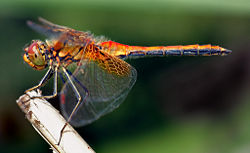 Yellow-winged Darter
| ||||||||||||
| Scientific classification | ||||||||||||
| ||||||||||||
|
Aeshnidae |
A dragonfly is an insect belonging to the order Odonata, the suborder Epiprocta or, in the strict sense, the infraorder Anisoptera. It is characterized by large multifaceted eyes, two pairs of strong transparent wings, and an elongated body.
Dragonflies typically eat mosquitoes, midges and other small insects like flies, bees, and butterflies. They are usually found around lakes, ponds, streams, and wetlands because their larvae, known as "nymphs," are aquatic. Dragonflies do not normally bite or sting humans (though they will bite in order to , if grasped by the abdomen); in fact, they are valued as a predator that helps control the populations of harmful insects, such as mosquitoes. It is because of this that dragonflies are sometimes called "mosquito hawks" in North America, along with crane flies (which, in fact, do not eat mosquitoes).
Life cycle
Female dragonflies lay eggs in or near water, often in or on floating or emergent plants. Some species when laying eggs will submerge themselves completely just to lay their eggs in a suitable place. Most of the life of the dragonfly is spent in the larval, (naiad, aka nymph) form, beneath the water surface, using internal gills to breathe, and using extendable jaws to catch other invertebrates or even vertebrates such as tadpoles and fish. The larvae of large dragonflies may live as long as five years, or two months to three years in smaller species. When the the larva is ready to metamorphose into an adult, it climbs up a reed or other emergent plant at night, and when it does the breathing pattern changes inside the larvae's body. Then the skin splits at a weak spot behind the head and the adult dragonfly crawls out of its old larval skin, waits for the sun to rise, pumps up its wings and flies off to feed on midges and flies. In the adult stage, larger species of dragonfly can live as long as four months.
Classification
Ancient dragonflies ("Anisozygoptera")
Conventionally, the Anisoptera were given suborder rank beside the ancient dragonflies ("Anisozygoptera," two living species and numerous fossil ones), but it has been determined recently that the Anisozygoptera form a paraphyletic assemblage of primitive relatives of the Anisoptera. Thus, the Anisoptera are reduced to an infraorder, forming the new suborder Epiprocta (dragonflies in a general sense). The artificial grouping Anisozygoptera is disbanded, its members being recognized as largely extinct offshoots at various stages of dragonfly evolution.
The oldest known species of dragonfly is the 320 million year old Delitzschala bitterfeldensis. Another old genus is Namurotypus.
Dragonflies vs. damselflies
Damselflies (Suborder Zygoptera) are often confused with dragonflies, but the two insects are distinct: most damselflies at rest hold their wings together above the body or held slightly open above (such as in the family Lestidae), whereas dragonflies at rest hold their wings horizontally or occasionally slightly down and forward. Also, the hindwing of the dragonfly broadens near the base, caudal to the connecting point at the body, while the hindwing of the damselfly is essentially similar to the forewing. The eyes on a damselfly are separated; in most dragonflies the eyes touch, with notable exceptions to this being in the Petaluridae (Petaltails) and the Gomphidae (Clubtails). Both are members of the Odonata, making their life cycles similar.
Some common species of the Northern Hemisphere
|
|
Some common species of the Southern Hemisphere
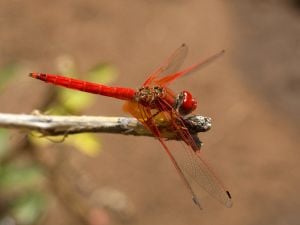
|
|
|
Dragonflies in culture
In Europe, dragonflies have often been viewed as sinister. Some English vernacular names, such as "devil's needle" and "ear cutter," link them with evil or injury.[1] A Romanian folk tale says that the dragonfly was once a horse possessed by the devil, and Swedish folklore holds that the devil uses dragonflies to weigh people's souls.[2] Another Swedish legend holds that trolls use the dragonflies as spindles when weaving their clothes (hence the Swedish word for dragonfly trollslända, lit. "troll's spindle") as well as sending them to poke out the eyes of their enemies.[citation needed] The Norwegian name for dragonflies is "Øyenstikker," which literally means Eye Poker. They are often associated with snakes, as in the Welsh name gwas-y-neidr, "adder's servant".[1] The Southern United States term "snake doctor" refers to a folk belief that dragonflies follow snakes around and stitch them back together if they are injured.[3] The Lithuanian word "Laumžirgis" is a composite word meaning "the Lauma's horse," while in Dutch, Aeshna mixta is called "Paardenbijter" or "horse biter." In some South American countries, dragonflies are also called matacaballo (horse killer), or caballito del diablo (devil's horse), since they were perceived as harmful, some species being quite large for an insect.
In East Asia and among Native Americans, dragonflies have a far better reputation, one that can also be said to have positively influenced modern day views about dragonflies in most countries.
For some Native American tribes they represent swiftness and activity, and for the Navajo they symbolize pure water. Dragonflies are a common motif in Zuni pottery; stylized as a double-barred cross, they appear in Hopi rock art and on Pueblo necklaces.[4] It is said in some Native American beliefs that dragonflies are a symbol of renewal after a time of great hardship.
In Japan dragonflies are symbols of courage, strength, and happiness, and they often appear in art and literature, especially haiku. In ancient mythology, Japan was known as Akitsushima, which means "Land of the Dragonflies." The love for dragonflies is reflected by the fact that there are traditional names for almost all of the 200 species of dragonflies found in and around Japan.[5] Japanese children catch large dragonflies as a game, using a hair with a small pebble tied to each end, which they throw into the air. The dragonfly mistakes the pebbles for prey, gets tangled in the hair, and is dragged to the ground by the weight.[6]
They also have traditional uses as medicine in Japan and China. In some parts of the world they are a food source, eaten either as adults or larvae; in Indonesia, for example, they are caught on poles made sticky with birdlime, then fried in oil as a delicacy.[1]
Vietnamese people have a traditional way to forecast rain by seeing dragonflies: "Chuồn chuồn bay thấp thì mưa, bay cao thì nắng, bay vừa thì râm" (Dragonflies fly at low level, it is rainy; dragonflies fly at high level, it is sunny; dragonflies fly at medium level, it is shadowy).
Images of dragonflies were common in Art Nouveau, especially in jewelry designs.[7] They have also been used as a decorative motif on fabrics and home furnishings.[8]
Gallery
- Dragon Fly.JPG
African dragonfly perched on a leaf
- Dragonfly23.JPG
Red-veined darter (Sympetrum fonscolombii) in Romania
See also
- Elliot Pinhey
Notes
- ↑ 1.0 1.1 1.2 Phillip S. Corbet (1999). Dragonflies: Behavior and Ecology of Odonata. Ithaca, NY: Cornell University Press, 559-561. ISBN 0-8014-2592-1.
- ↑ Forrest L. Mitchell and James L. Lasswell (2005). A Dazzle of Dragonflies. College Station, TX: Texas A&M University Press, 25-27. ISBN 1-585-44459-6.
- ↑ Wayland D. Hand (1973). From Idea to Word: Folk Beliefs and Customs Underlying Folk Speech. American Speech 48 (1/2): 67-76. - Retrieved October 15, 2007.
- ↑ Mitchell and Lasswell, 20-26.
- ↑ Gilbert Waldbauer (1998). The Handy Bug Answer Book. Detroit: Visible Ink Press. ISBN 1-57859-049-3.
- ↑ Mitchell and Lasswell, 38.
- ↑ Wendy Moonan, , "Dragonflies Shimmering as Jewelry", New York Times, August 13, 1999, pp. E2:38.
- ↑ Elizabeth Large, , "THE LATEST BUZZ; In the world of design, dragonflies are flying high", The Sun (Baltimore, MD), June 27, 1999, pp. 6N.
External links
All links retrieved October 15, 2007.
- Odonata - Tree of Life
- Open Directory Project - DMOZ
- Dragonflies of North America - diagnostic photos and information - cirrusimage.com
- Identification key to dragonflies found in Ireland - habitas.org.uk
- study and conservation of dragonflies and their natural habitats - British Dragonfly Society
- List of Anisoptera of the World - ups.edu
- Photos of most British species - brocross.com
- Dragonflies and Damselflies (Odonata) of the United States - USGS
- Checklists, photogallery,... Dragonflies of Kerala, South India. - Green Explorer
- Photogallery - by Dan Bárta et al.
- DragonflyIndia Group - Yahoo! Tech
- ECHO and PHAON - Africa Dragonfly
- Odonatologica - Journal of the Societas Internationalis Odonatologica
- Photos of South African species by Greg Lasley
- Maps, photographs and additional information pertaining to the Odonata of North America - Odonata Central
- Short film, "Emergence of a Dragonfly" - NFB
Credits
New World Encyclopedia writers and editors rewrote and completed the Wikipedia article in accordance with New World Encyclopedia standards. This article abides by terms of the Creative Commons CC-by-sa 3.0 License (CC-by-sa), which may be used and disseminated with proper attribution. Credit is due under the terms of this license that can reference both the New World Encyclopedia contributors and the selfless volunteer contributors of the Wikimedia Foundation. To cite this article click here for a list of acceptable citing formats.The history of earlier contributions by wikipedians is accessible to researchers here:
The history of this article since it was imported to New World Encyclopedia:
Note: Some restrictions may apply to use of individual images which are separately licensed.
